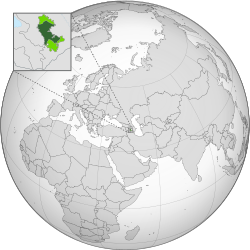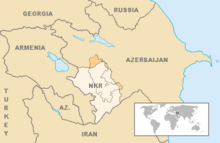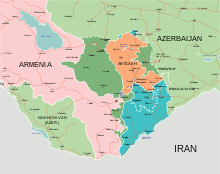Republic of Artsakh
Republic of Artsakh Արցախի Հանրապետություն Artsakhi Hanrapetutyun Нагорно-Карабахская Республика Nagorno-Karabakhskaya Respublika | |
|---|---|
| Anthem: Ազատ ու Անկախ Արցախ (Armenian) Azat u Ankakh Artsakh (transliteration) "Free and Independent Artsakh" | |
 Territory controlled by Artsakh in dark green, claimed territory in light green. | |
| Status | Unrecognised state Recognised by 3 non-UN members |
| Capital and largest city | Stepanakert 39°52′N 46°43′E / 39.867°N 46.717°E |
| Official languages | Armenian and Russian |
| Demonym(s) | Artsakhi |
| Government | Unitary presidential republic |
| Samvel Shahramanyan | |
| Arthur Tovmasyan | |
| Legislature | National Assembly |
| Independence from the Soviet Union | |
• Autonomy | 2 September 1991[1] |
• Declared | 10 December 1991 |
| Area | |
• Total | 3,170 km2 (1,220 sq mi)[source?] |
| Population | |
• 2015 census | 150,932[2] (191st) |
| GDP (PPP) | 2019 estimate |
• Total | $713 million (n/a) |
• Per capita | $4,803 (n/a) |
| Currency | (AMD) |
| Time zone | UTC+4 (AMT) |
| Driving side | right |
| Calling code | +374 47c |
| ISO 3166 code | AM |
| Internet TLD | .am, .հայ |
| |
Artsakh (officially the Republic of Artsakh; /ˈɑːrtsæx/; Armenian: Արցախի Հանրապետություն, Artsakhi Hanrapetutyun), or the Nagorno-Karabakh Republic (/nəˌɡɔːrnoʊ kærəˈbæk/),[3] was a separatist state in the Nagorno-Karabakh region of the South Caucasus. It controlled its own land but is legally part of Azerbaijan.
History[change | change source]
Armenian people have lived there since classical antiquity. In the 11th century the Seljuk invasion swept over the Middle East, including the South Caucasus. Nomadic Turkic Oghuz Seljuk tribes, which also include the Azerbaijanis, came during this invasion. They became dominant in Nagorno-Karabakh.[4] From this time, until the beginning of the 20th century, these tribes used Mountainous Karabakh as their summer pastures. They stayed there for about four to five months per year, and in fact, they owned the region.[5][6]
Armenia and Azerbaijan have disputed the area since 1918. After the Soviet Union established control over the area, in 1923 it formed the Nagorno-Karabakh Autonomous Oblast (NKAO) within the Azerbaijan SSR. In the final years of the Soviet Union, Armenia and Azerbaijan started to dispute the region again. This dispute caused the Nagorno-Karabakh War from 1993 to 1994.
On 10 December 1991, a referendum (vote) was held in the NKAO and the neighbouring Shahumian region. The referendum asked voters the question: "Should this area be independent from Azerbaijan?" The Azerbaijani people boycotted the referendum: they protested by choosing not to vote. This resulted in a declaration of independence from Azerbaijan as the Nagorno-Karabakh Republic. The country was not recognized by any UN member state, including Armenia.
There was dispute over the country's status ever since it was created. Azerbaijan claimed that they had the right to control Artsakh. Armenia supported Artsakh. From 2020 to 2023, there were multiple fights between Artsakh and Azerbaijan. On 28 September 2023, President Samvel Shahramanyan signed a deal with Azerbaijan's government to close down Artsakh's government by 1 January 2024, bringing an end to Artsakh. By October, almost all of the population had fled to Armenia.


Geography[change | change source]
The Artsakh Republic has a lot of mountains. It is 11,500 km2 (4,440 sq mi) in area, and borders Armenia, Azerbaijan, and Iran. The highest peaks in the country are Mount Mrav, 3,340 metres (10,958 ft), and Mount Kirs 2,725 metres (8,940 ft). The major rivers are the Terter and Khachen rivers.[7] Most rivers in the country flow towards the Artsakh valley.[8]
The climate in the Artsakh Republic is mild. It is foggy for over 100 days a year. More than 36% of the country is forested.
Demographics[change | change source]
In 2005, the country's population was 137,737. The ethnic composition was 137,380 (99.74%) Armenians, 171 (0.12%) Russians, 21 (0.02%) Ukrainians, 6 (0.00%) Azerbaijanis and 159 (0.12%) others.
The first demographic census in the Artsakh Republic took place in 1769. It was a letter from Heraclius II of Georgia to Russia's Petr Ivanovich Panin, and said, "Seven families rule the region of Khamse. Its population is totally Armenian." [9][10]
In 2014, the life expectancy for males was 71.6 years, and females 76.8 years.[11]
References[change | change source]
- ↑ Zürcher, Christoph [in German] (2007). The Post-Soviet Wars: Rebellion, Ethnic Conflict, and Nationhood in the Caucasus ([Online-Ausg.]. ed.). New York: New York University Press. p. 168. ISBN 9780814797099.
- ↑ "ԼՂՀ 2015Թ. ՄԱՐԴԱՀԱՄԱՐԻ ՆԱԽՆԱԿԱՆ ՕՊԵՐԱՏԻՎ ՑՈՒՑԱՆԻՇՆԵՐԻ ՄԱՍԻՆ". STAF NKRE. 30 March 2016. Archived from the original on 16 April 2016. Retrieved 30 March 2016.
- ↑ "Constitution of the Republic of Artsakh". Ministry of Foreign Affairs – Republic of Artsakh. Archived from the original on 2018-12-30. Retrieved 2020-04-19.
The names 'Republic of Artsakh' and 'Republic of Nagorno-Karabakh' are identical.
- ↑ "Azerbaijan". Encyclopædia Britannica.
- ↑ Olcott, M.; Malashenko, M. (1998). Традиционное землепользование кочевников исторического Карабаха и современный армяно-азербайджанский этнотерриториальный конфликт (Анатолий Ямсков) [The Traditional Land-use of the Nomads of Historical Karabakh and the Modern Armenian-Azerbaijani Ethno-territorial Conflict (by Anatoly N. Yamskov)]. Фактор этноконфессиональной самобытности в постсоветском обществе [The Factor of Ethno-confessional Identity in the Post-Soviet Society]. Московский Центр Карнеги (The Moscow Center of Carnegie). pp. 179–180. ISBN 0-87003-140-6.
This seasonal coexistence in the mountains of historical Karabakh with a sedentary Armenian population and a nomadic Turkic one, as well as some Kurdish, completely assimilated by Azerbaijanis in the 19th–20th centuries, arose a long time ago, simultaneously with the great movement of nomadic pastoralists into the plains of Azerbaijan.
Указанная ситуация сезонного сосуществования в горах исторического Карабаха оседлого армянского и кочевого тюркского населения, а также частично и курдского, полностью ассимилированного азербайджанцами в XIX—XX вв., возникла очень давно, одновременно с массовым проникновением кочевых скотоводов на равнины Азербайджана.
- ↑ Yamskov, A. N. (June 22, 2014). "Ethnic Conflict in the Transcausasus: The Case of Nagorno-Karabakh". Theory and Society. 20 (5, Special Issue on Ethnic Conflict in the Soviet Union) (published October 1991): 650 – via JSTOR.
The Azeri conception of Karabakh as an inseparable part of Azerbaijan is based on other considerations than the oblast's ethnic composition. The Armenians have resided in Karabakh for a long time, and they represented an absolute majority of its population at the time that the autonomous oblast was formed. However, for centuries the entire high mountain zone of this region belonged to the nomadic Turkic herdsmen, from whom the Khans of Karabakh were descended. Traditionally, these direct ancestors of the Azeris of the Agdamskii raion (and of the other raions between the mountains of Karabakh and the Kura and Araks Rivers) lived in Karabakh for the four or five warm months of the year, and spent the winter in the Mil'sko-Karabakh plains. The descendants of this nomadic herding population therefore claim a historic right to Karabakh and consider it as much their native land as that of the settled agricultural population that lived there year-round.
- ↑ "Nagorno Karabakh Republic – Country Overview". Nkrusa.org. Retrieved 6 May 2012.
- ↑ "The Office of the Nagorno Karabakh Republic in USA". Nkrusa.org. Retrieved 6 May 2012.
- ↑ Цагарели А. А. Грамота и гругие исторические документы XVIII столетия, относяшиеся к Грузии, Том 1. СПб 1891, ц. 434-435. This book is available online from Google Books
- ↑ Bournoutian, George A. Armenians and Russia, 1626-1796: A Documentary Record. Costa Mesa, CA: Mazda Publishers, 2001, page 246
- ↑ "The National Statistical Service of Nagorno-Karabach Republic". Archived from the original on 2011-10-03. Retrieved 2016-12-31.
Other websites[change | change source]
- Official websites
- Ministry of Foreign Affairs of the Nagorno-Karabakh Republic Archived 2017-09-17 at the Wayback Machine
- Office of the Nagorno-Karabakh Republic, Washington D.C.
- National Statistical Service of NKR Archived 2008-02-06 at the Wayback Machine
- President of the Nagorno Karabagh Republic
- Media


